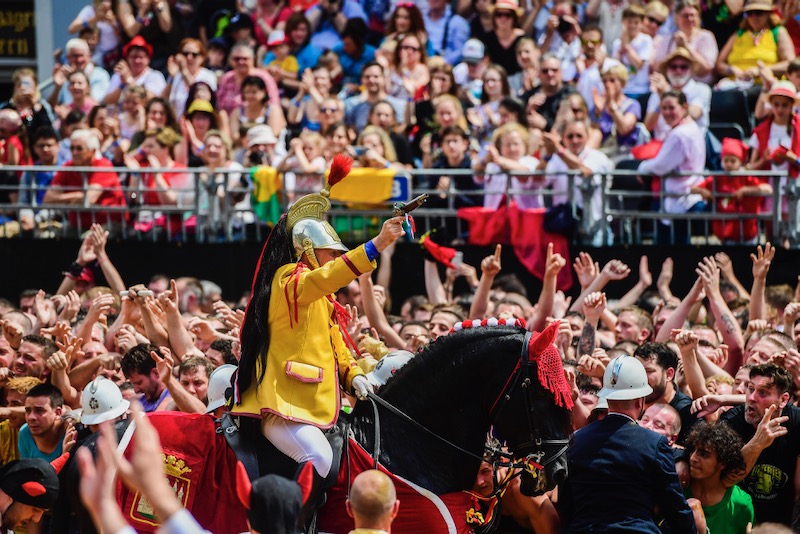It’s a fair bet that the majority of people in England have only the vaguest notion that the feast of their national saint falls today and will know little about St George other than he’s supposed to have killed a dragon.
This, I think, does him a massive disservice.
Martyr, mythical hero, trusted intercessor and a focus of community cohesion with international and cross-cultural appeal, there’s so much about the saint – in fact and legend – that makes him an ideal patron for modern England. And, I’d suggest his feast is especially relevant this year due to the extraordinary challenges we’re currently facing.
So who was St George?
To be perfectly honest, not that much is known about him as a historical person. It’s likely that he was among those who suffered for their faith during the last great persecution of the Church initiated in 303 by the Roman Emperor Diocletian. A mid-fourth-century inscription from modern-day Syria provides the earliest evidence of his veneration and specifically states he was a martyr. From an early date, devotion to the saint (or his cult) was focused on the Roman city of Diosplis, present-day Lod, in Israel. This was attracting pilgrims from at least the sixth century.
By then more details were being added to the saint’s story. He was identified as a soldier in the Roman army who suffered a hideous martyrdom for his refusal to sacrifice to pagan gods.
Veneration of St George spread across the Mediterranean basin, sowing the seeds of an international dimension to his cult that blossomed during the Middle Ages and still characterizes his veneration (however you choose to define it) in the 21st century.
The military associations of St George were amplified during the Crusades. He was believed to have appeared to assist the Christian armies during the sieges of Antioch in 1098 and Jerusalem in 1099. This relationship with the Crusades has resulted in St George becoming a poster-boy of far right groups, who have sought to cast him as a personification of Christian resistance to militant Islam.
They’ll therefore be disappointed to learn that his shrine in the Holy Land was (and to some extent, still is) venerated by not only Christians but also Muslims and Jews. Moreover, George was conflated with the Islamic prophet and holy man, al-Khadir.
Nor do suggestions that it was during the Third Crusade (1189-92) that the English adopted the banner of St George as their own don’t stand up to scrutiny. It wasn’t until the time of Henry VIII that it became the national flag. Nor, as is often claimed, did Richard I, the Lionheart, have a special devotion to the saint. Among the saints he favoured was Pope Gregory the Great, regarded in the Middle Ages as the Apostle of the English because he had dispatched St Augustine to convert the pagan Anglo-Saxons.
In fact, it wasn’t until the mid-13th century that George became firmly associated with the English nation, especially the Crown and at times of war.
Veneration of George always had a strong popular dimension. This was helped along by his dragon-slaying powers. Depictions of the saint in combat with the fearsome serpent date from at least the 9th century. The popularity of the story was turbo-charged thanks to its inclusion in the Golden Legend, a collection of saints’ lives by Jacobus de Voragine, an Italian Dominican friar, completed in 1265. This tells how the handsome George, the embodiment of Christian chivalric virtue, rescued a chaste princess of the city of Silene in Libya from the dragon, spearing it with his lance.
George’s name was invoked in battle cries, most famously at Agincourt in 1415. However, his appeal extended far beyond the medieval soldiery. The saint – especially in German speaking lands – came to be included among a select group of holy personages known as the Fourteen Holy Helpers; especially empathetic saints whose prayers of intercession were believed to have a high chance of success, especially at times of personal and communal crisis.
In common with St George, many of the Holy Helpers were early Christian martyrs with colourful legends describing their piety, fantastical deeds and sufferings for Christ. These same legends provided the basis for their association with particular ailments. George was no exception. His slaying of the scaly-skinned dragon meant that his assistance was sought against diseases with dermatological manifestation. Many of these had infectious causes, including leprosy, plague, syphilis and a vast array of hideous ulcerative disorders that are a source of bemusement for modern medical historians.
It’s arguable that given the limited state of medical knowledge at the time, the prayers pleading for St George’s intercession were as likely to have been as beneficial as any therapy offered by a physician. The treatment of disease in the Middle Ages had a strong spiritual dimension: it was the next world that really mattered.
The friendship offered by St George transcended contested political borders and the boundaries of a rigid class structure. The saint was – and remains – the patron of numerous polities across Europe and beyond, including not only England but also parts of Germany, Portugal, Armenia, the cities of Antioch, Barcelona and Genoa. The country of Georgia is even named in his honour. At times of crisis, traditional enemies would turn to St George against the unseen foe of disease.
St George was also part of the glue that bound medieval society together. Many towns had civic guilds founded in his honour. Membership provided status, a sense of belonging and was also a source of mutual aid and charity in times of need. These same guilds staged elaborate pageants on their patron’s feast, which were enjoyed by rich and poor alike. Their chaplains were also there to provide succor and the sacrament to the sick and dying.
A friend, protector and source of unity: I think there’s plenty in St George that deserves to be honoured this year. Let’s hope that social distancing has eased up next year and we can have a celebratory pageant too.



 Loading ...
Loading ...
What do you think?
You can post as a subscriber user ...
User comments (0)